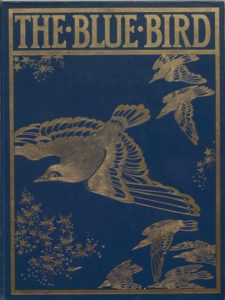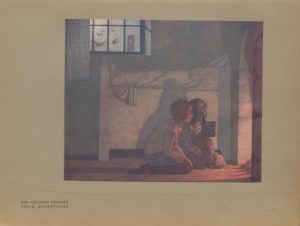Maurice Maeterlinck, The Blue Bird, a fairy play in six acts, 1911

Maurice Maeterlinck, The Blue Bird, a fairy play in six acts, translated by Alexander Teixeira de Mattos, illustrated by Frank Cayley Robinson, (London: Methuen, 1911). Loaned by the Harris Museum, Art Gallery and Library. Image © Harris Library, Preston.
Monday 6 April 2020
By Dr Cynthia Johnston, Institute of English Studies, School of Advanced Study, University of London
Belgian playwright, Maurice Maeterlinck (1862-1949), was one of the most well-known literary figures of his day. Renowned in Europe and America as a leading figure in the Symbolist movement, he wrote 26 plays, produced 3 volumes of poetry and published many influential essays and translations. His work inspired composers such as Gabriel Fauré, Claude Debussy and Jean Sibelius. The poet, Edward Thomas, wrote a critical biography of Maeterlinck in 1911. Maeterlinck was awarded the Nobel Prize for Literature in 1911, but his work is largely forgotten today.
This play, The Bluebird, was translated from the French, the language which Maeterlinck preferred for his literary work. It was first produced in Moscow in Stanislavski’s Moscow Art Theatre and premiered on Broadway in 1910. The subject is the pursuit of happiness. Two children of a forester are transported on an adventure in which they encounter both good and evil. A visit from a fairy on Christmas Eve enables the children to see the fairy world. They are transported by the blue bird. Their visits include ‘The Land of Memory’ where they converse with their departed grandparents, as well as ‘The Kingdom of the Future’ where they meet the unborn who will bring to earth both marvellous inventions and terrible harm. The moral lesson of the piece seems to be that one must pursue happiness, and question one’s experiences in that quest, to achieve a state of enlightenment. The aim of life is a progression, not a state of equilibrium.
One contemporary American critic compared the tableau of the play to that of Shakespeare’s Mid-summer’s Night Dream as well as to J.M. Barrie’s Peter Pan. The comparison seems most apt for Barrie’s work though, especially the ability of the work to engage both children and adults.

Illustration by Frank Cayley Robinson. From The Blue Bird, a fairy play in six acts by Maurice Maeterlinck, 1911. Loaned by the Harris Museum, Art Gallery and Library. Image © Harris Library, Preston.
Spencer’s copy is illustrated by Frederick (Frank) Cayley Robinson (1862-1927) an important British painter of the fin de siècle. Robinson studied contemporary painting in Paris in the 1890s where he was influenced by the work of Pierre Puvis de Chavannes, who rejected the plein air approach of the Impressionists, and preferred to paint the conceptual ‘Ideal’. Following Puvis, Robinson’s work uses idealised figures in mythic settings. He is more concerned with symbolic meaning than with optics or naturalism. Robinson’s approach perfectly accommodated the goals of Maeterlinck and the Symbolists. Robinson also designed the stage set for the New York production.
Next time: John Henry Spencer’s Children’s book collection continued.